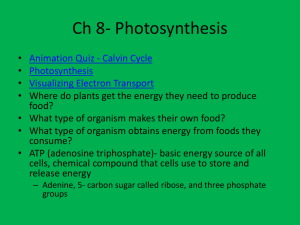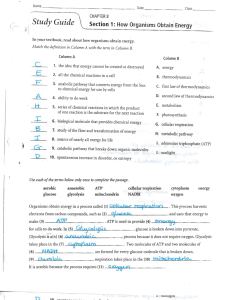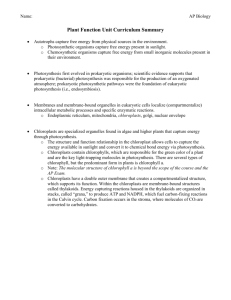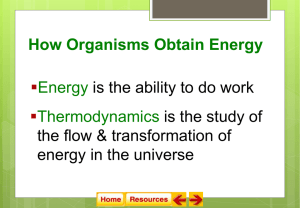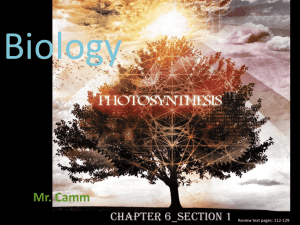Photosynthesis
advertisement
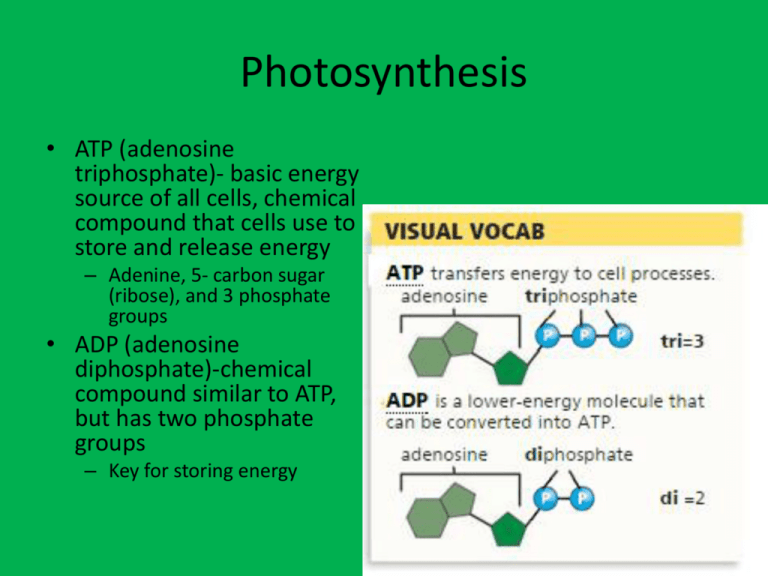
Photosynthesis • ATP (adenosine triphosphate)- basic energy source of all cells, chemical compound that cells use to store and release energy – Adenine, 5- carbon sugar (ribose), and 3 phosphate groups • ADP (adenosine diphosphate)-chemical compound similar to ATP, but has two phosphate groups – Key for storing energy • How is the energy that is stored in ATP released? – Chemical bond between second and third phosphate group is broken • Because of the characteristics of ATP, it is an exceptional source of energy • Organisms break down carbon –based molecules to produce ATP – Carbohydrates – Proteins – Lipids Sec 2- Photosynthesis: An Overview • Photosynthesis- series of reactions that uses light energy from sun to convert water and carbon dioxide into sugars and oxygen • What does photosynthesis require? – Sunlight, water, CO₂ and chlorophyll-molecule in chloroplast • Plants gather the sun’s energy with light absorbing molecules called pigments • Chlorophyll- principal light absorbing pigment – Chlorophyll a and chlorophyll b – Absorbs light very well in certain regions of visible spectrum, green light is reflected Overview of Photosynthesis • Photosynthesis takes place in chloroplasts – Grana (thylakoids) – Stroma • Thylakoids- sac-like photosynthetic membranes inside chloroplasts – Arrange in stacks known as grana Overview of Photosynthesis • Light-dependent reactions capture energy from sunlight – – – – Takes place in thylakoids Water and sunlight are needed Chlorophyll absorbs energy Energy is transferred along thylakoid membrane then to lightindependent reactions – Oxygen is released Overview of Photosynthesis • Light-independent reactions (Calvin Cycle)- make sugars – Take place in stroma – Needs carbon dioxide from atmosphere – Uses energy to build a sugar in a cycle of chemical reactions Overview of Photosynthesis • The equation for overall process is – Proteins in thylakoids organize chlorophyll into photosystems – 2 types of photosystems- light collecting units of the chloroplast – 2 types of reactions in photosystems- light dependent reactions and light independent reactions= Calvin cycle – Light dependent reactions-thylakoid membranes – Calvin cycle= stroma, a region outside thylakoid membranes Electron Carriers • Sunlight excites electrons in chlorophyll= great deal of energy • Electron carriers transport high energy electrons from chlorophyll to other molecules • NADPᶧ- electron carrier • High energy electrons used to build molecules for cell Light Dependent Reactions • Requires light • Converts ADP and NADPᶧ into ATP and NADPH and produces oxygen • Steps of light dependent reaction – Light is absorbed by electrons in photosystem II Are electrons ever used up? Where do the electrons come from? – High energy electrons move through electron transport chain to photosystem I – Photosystem I reenergizes electrons released. Electrons are used to form NADPH – Positively charged hydrogen ions fill up thylakoid membrane – Hydrogen ions pass through ATP synthase, ADP is converted into ATP Calvin Cycle • Plants use energy that ATP and NADPH contain to build high energy compounds • Does not require light, known as light- independent reactions • Steps of Calvin cycle – CO₂ enters the cycle, 6 carbon dioxide molecules combined with six 5 carbon molecules to form twelve 3- carbon molecules – ATP and NADPH are used to convert twelve carbon molecules into higher energy forms – Two 3 carbon molecules removed from cycle to form sugars, lipids, amino acids – 10 remaining 3- carbon molecules converted into six 5- carbon molecules- used in next cycle • Plants use sugars to build cellulose



